Remote Setup Guide¶
Gaining Access to your Systems¶
The CDC runs on a large VMware cluster. You will be managing your systems using vCenter.
Using the vSphere HTML5 Client (new)¶
vCenter has a new HTML5 based web client. Most features are implemented, but occasionally you may need to use the Flash web client. The missing features are documented on VMware’s website.
Go to https://vcenter.iseage.org and select “vSphere Client (HTML5) - partial functionality.” Log in with username@iseage.org. This username is the same one that is assigned to you to login via IScorE.
We suggest installing the VMware Remote Console (supported by Windows, Linux, and macOS) for an optimal experience.
If you have any issues with the HTML5 client, try Using the vSphere Flash Web Client (preferred).
Using the vSphere Flash Web Client (preferred)¶
Go to https://vcenter.iseage.org and select “vSphere Web Client (Flash).” Log in with username@iseage.org. This username is the same one that is assigned to you to login via IScorE.
We suggest installing the VMware Remote Console (supported by Windows, Linux, and macOS) for an optimal experience.
If you are unable to get the Web Client working, you may access it via our RDP hop (see Connecting to the RDP Hop). However, if everyone did this, the RDP hop will not be able to handle it.
Whether or not you use the vSphere Web Client locally, you can still use the RDP hop to test that your servers are working on the network, see Testing Your Systems.
Using the vSphere Web Clients Remotely (not preferred)¶
Important
In order to reduce the load on our systems, we ask that you not use the vSphere Web Client over RDP unless a compatibility issue prevents you from doing so.
If you can’t get the Web Client working on your machine, it is also available from the RDP hop (see Connecting to the RDP Hop). Once connected to the RDP hop, follow the instructions for either Using the vSphere HTML5 Client (new) or Using the vSphere Flash Web Client (preferred).
Testing Your Systems¶
Since the CDC runs on a simulated internet provided by ISEAGE, you’ll need to use our RDP hopping point or VPN to test your systems.
Connecting to the RDP Hop¶
The RDP hop point is available at rdp.iseage.org.
Windows¶
Use Remote Desktop Connection. You can run Remote Desktop Connection by
doing start run mstsc. Then log in using username@iseage.org in the
User name field your password.
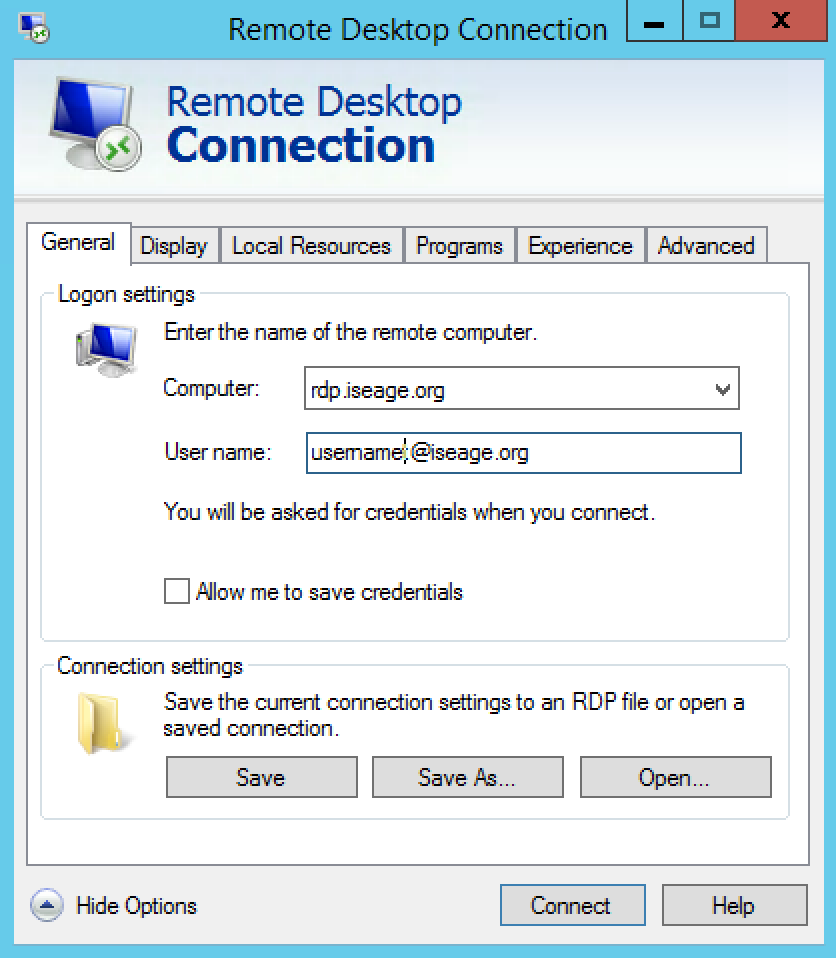
The login window for Remote Desktop Connection
macOS¶
On macOS use Microsoft Remote Desktop. You can get from the app store, for free, https://itunes.apple.com/us/app/microsoft-remote-desktop/id715768417. Once installed click “New” in the top.

The new button
Then use rdp.iseage.org as the PC Name, then
enter username@iseage.org as the user name.

The connection details for Remote Desktop
Linux¶
On Linux: use your favorite package manager to install rdesktop or another RDP
client. Use `ISEAGE` as the domain.
Connecting to the VPN¶
As an alternative to the RDP hop, you may use the VPN to connect to our network. The VPN allows your personal computer to connect directly to your machines just like you would on-site, making it very easy to interact with and test your systems.
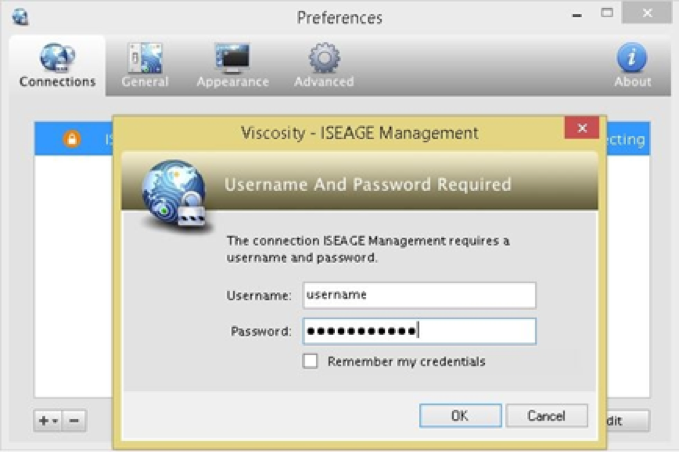
Viscosity OpenVPN Client
Clients¶
Connecting to the VPN¶
Once you have the client installed, visit https://download.iseage.org/vpn. If you are using Viscosity or another client that uses .visz files, download the ISEAGE Management.visz file. Otherwise, you can download the .ovpn file.
Simply double click on the .visz file and Viscosity will import it. Right click on the new connection, and choose “Connect”. Enter your username and password as shown; do not append @iseage.org to the username.
If you aren’t using Viscosity, follow the directions for your VPN client.
Changing your Password¶
All CDC systems use a central authentication system. The credentials have been
provided for you via email. If you wish to change your password, login to the
RDP hop and press CTRL + ALT + END (FN + CTRL + OPTION + DELETE
on a Mac), then “Change a password”.
Managing your Virtual Machines (VMs)¶
When you log in for the first time, you will see a “Getting Started” page. Click the “x” in the upper right so you can go directly to the “Home” tab when you login.

Click the X to close. The help menu is in the upper right as well.
Creating new VMs¶
To make a new VM, right-click your folder and choose “New Virtual Machine”. The wizard will guide you through creating a new VM.
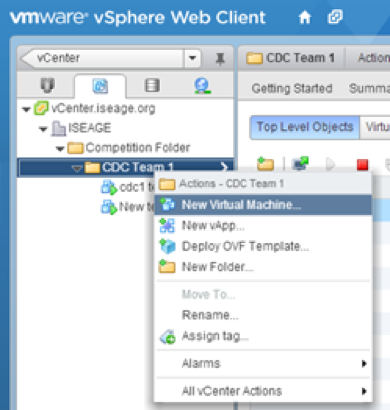
Select “New Virtual Machine”
Important
When you name your VMs, please include your Team Number in the title (for example: Team 1 RDP) – this will allow support staff to quickly find your VM if we need to assist you.
In step 2b, expand the tree until you arrive at “CDC Team N”
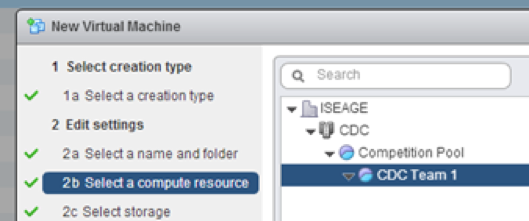
Expand the tree
In step 2c, choose “CDC Storage” datastore cluster.
Step 2f is where you will be allocating CPUs, RAM, and disk space. Expand the “New hard disk” section and choose “Thin provision” (see below). Thin provisioning only allocates the disk space your VMs actually use, instead of the size of the hard drive you choose.

Expand “New Hard Disk”
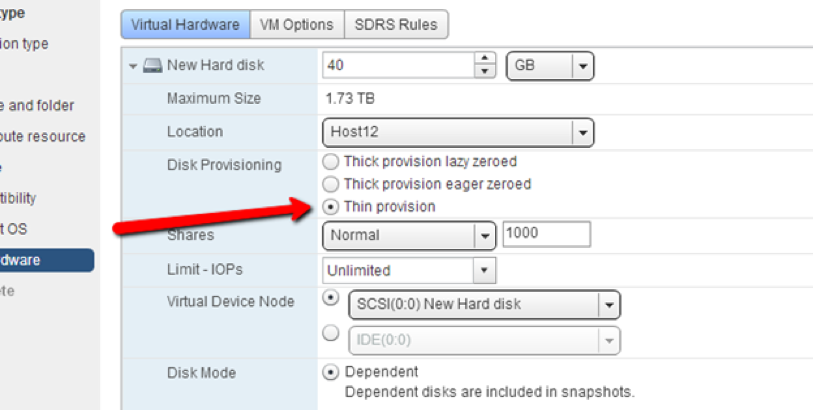
Select “Thin provision”
Attention
If you do not do the above step, you may Exceed your disk quota of 500 GB. If your VMs begin to take up too much disk space, we will work with you to correct the issue.
- Many of the settings in this step can be changed later (such as networks and RAM allocation) by right-clicking the VM and choosing “Edit Settings”. However, the size and format of a hard disk cannot be changed after it is created.
- It is rarely necessary to assign more than 2 to 4 CPU cores. If you feel like your VM would benefit from more cores, you are required to consult with support staff before proceeding.
Attention
We also ask that you keep your total RAM usage under 35 GB. It is unlikely you will hit this cap, but, for instance, don’t allocate 4 GB of RAM to a firewall. Use good judgment about allocating resources.
Installing Operating Systems¶
CDC staff have created an easy way for you to download and use ISOs for your OS installations. Visit http://isodatastore.iseage.org in your favorite browser and make sure your ISO isn’t already in the list. Paste the full URL to an ISO file, then click “Initiate Transfer”. Once that transfer has completed you will be notified that the ISO was downloaded successfully. This can take a LONG time, so please resist the temptation to press the “Initiate Transfer” button multiple times.
To use an ISO, right-click a VM and choose “Edit Settings”. In the “CD/DVD Drive 1” section, choose “Datastore ISO File” from the drop-down menu. After you select the ISO you want, make sure to click the “Connect” checkbox.
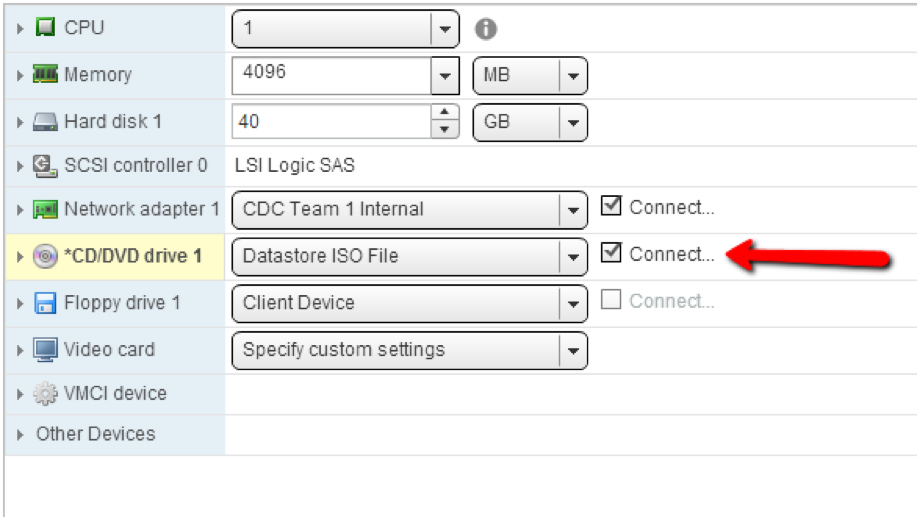
Select “Connect”
Post-installation¶
If you find that the vSphere Client does not allow you to perform an action you would like (such as creating a virtual network, file move operations, etc), please contact support.
Once you have installed the operating system and configured networking, we recommend switching to a different method of remote management for your VMs, such as RDP or SSH. You can use the RDP hop or VPN as explained above. For SSH, we have provided PuTTY on the RDP hop, the icon for which you can find on the desktop.
When you arrive on-site, you will be able to directly access your servers without using the RDP hop or VPN.
Getting Help¶
If you need any help, go to https://setup.iseage.org in your favorite web browser. Log in with your CDC credentials. Support Chat is available to help you set up in real-time. Online chat will be staffed to the best of our ability; hours we will be available can be found on the setup website’s calendar. This chat room should be used to ask for help with problems with your VMware installation, help installing or configuring software, or other technical questions. Rule clarifications, disputes, or other non-technical issues should be sent via email to cdc_support@iastate.edu.
Note
During setup and the competition, CDC Staff will not give the Red Team access to your team’s consoles in the VMware environment. The VMware cluster has not been tampered with in any way; there are no secret backdoors, keyloggers, viruses, unicorns, monsters, etc. Additionally, your server hardware will not be accessible to the Red Team at any time during setup or the competition. Staff and White Team are here to help you. We aren’t trying to trick you or fraud you, we’re only here to make sure you can do your best.
